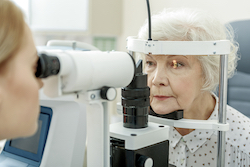3D OCT imaging for early screening of eye diseases
OCTLIGHT was built around optical coherence tomography (OCT), a technology that enables cross-sectional imaging of the eye. Combining this technology with appropriate medication has already reduced the number of age-related macular degeneration (AMD) patients who turn blind by 50 %. And we have only scratched the surface of its potential. Until OCTLIGHT came along, OCT could only be used by ophthalmologists. Yet, our eyes’ constant movements made it impossible to obtain complete 3D OCT images: Ophthalmologists could only use partial, 2D images as the technology just wasn’t fast enough to keep up with these movements. Another problem was that, whilst healthcare professionals tend to agree that earlier diagnosis of AMD would enable treatment with anti-vascular endothelial growth factor (VEGF) at an earlier disease stage, opticians do not have access to the robust diagnostics screening technology necessary to make this happen. The technology commercialised by OCTLIGHT, which is 10 times faster than current solutions, solves both problems by enabling affordable, robust wide-field 3D imaging of the retina. It can address not only AMD, but also other major eye diseases such as glaucoma and diabetic retinopathy. Funding under the EASED3D project allowed the company to investigate the clinical case for 3D OCT, survey the IPR landscape, and draw up a business plan, among other things. Project findings confirm that there is tremendous potential for improved and earlier diagnosis of eye diseases using OCTLIGHT 3D imaging technology. “There is a unique opportunity to bring our technology to both ophthalmologists and opticians, thereby providing cost savings to the healthcare system from increased efficiency. This would considerably improve the outcomes of treatment of chronic diseases,” says Thor Ansbæk, CEO of OCTLIGHT. A user-friendly technology Up until now, opticians had to use camera-based fundus photography for early diagnosis. But this technology led to many false-positives, to the point where ophthalmologists found themselves losing much time and resources on additional screening. OCTLIGHT’s technology is expected to reduce the rate of false-positives by including the “third dimension” of the retinal layers. For this to happen, high quality images allowing for the use of machine learning were required. “Machine learning can be used to train algorithms to do the same assessment of 3D OCT images for features of AMD, which means that opticians can get access to diagnostic support devices that will help them find cases of AMD without diagnostics training,” Ansbæk explains. OCTLIGHT is currently commercialising the technology as a OCT swept source product that ophthalmic med-tech companies can build around for a wide-field 3D OCT screening equipment. “We are working on the in-vivo demonstration of wide-field 3D OCT imaging on human subjects,” Ansbæk points out. When it comes to future plans, OCTLIGHT is currently applying for Phase 2 funding. “The plan is to commercialise the technology by demonstrating a full 3D OCT screening device for commercialisation by strategic partners. The swept source product at 1060 nm centre wavelength offered by OCTLIGHT also finds applications in many other areas such as full-eye biometry, real-time OCT imaging during surgery and other areas where real-time 3D optical biopsy with near histological resolution can be used to increase efficacy,” Ansbæk says. ”The eye is a window into the body, and robust and affordable 3D imaging could provide screening for many chronic diseases that pose serious challenges for society.”







